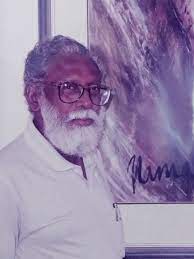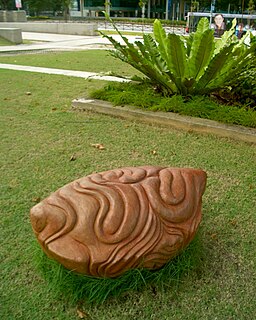Related Research Articles

LASALLE College of the Arts is a publicly-funded post-secondary arts institution, and a soon-to-be University of the Arts by 2023 in alliance with Nanyang Academy of Fine Arts in Singapore.
LGBT art in Singapore, or queer art in Singapore, broadly refers to modern and contemporary visual art practices that draw on lesbian, gay, bisexual, and transgender+ imagery and themes, addressing topics such as LGBT rights, history and culture in Singapore. Such queer art practices are often by Singaporean or Singapore-based visual artists and curators who identify as LGBT+ or queer.
The Institute of Contemporary Arts (ICA) Singapore is the curatorial division of LASALLE College of the Arts, dedicated to supporting innovative and emerging creative practices. Focusing on art and design from the present, it provides an active site for contemporary culture in Singapore. It comprises five galleries that span a total of 1,500 square metres, one of the largest spaces devoted to contemporary art in Singapore. It engages local and international audiences in critical viewing and discussion through a diverse programme of exhibitions, projects, publications and events.

The culture of Singapore has changed greatly over the millennia. Its contemporary modern culture consists of a combination of Asian and European cultures, mainly by Malay, South Asian, East Asian and Eurasian influences. Singapore has been dubbed as a country where "East meets West", "Gateway to Asia" and a "Garden city".

Ho Ho Ying is a Singaporean abstract artist known for his avant-garde Chinese calligraphy and his Abstract Expressionistic works of art unique to Asian ideology. He is also an accomplished author under his reputed moniker Zǐ Mù (子木), and an art critic for the Singapore visual arts community.

Ng Eng Teng, The Grandfather of Singapore Sculpture was a sculptor in Singapore known for his figurative sculptures, many of which are found in public locations around Singapore. His legacy include the Mother And Child bronze sculpture outside Far East Shopping Centre along Orchard Road, and The Explorer located at the entrance of the Singapore Art Museum.

The Artists Village (TAV) is a Singapore-based contemporary art group. It is known as Singapore's first art colony, founded by contemporary artist Tang Da Wu in 1988.
Tang Da Wu is a Singaporean artist who works in a variety of media, including drawing, painting, sculpture, installation art and performance art. Educated at Birmingham Polytechnic and Goldsmiths' College, University of London, Tang gave his first solo exhibition, consisting of drawings and paintings, in 1970 at the Singapore Chinese Chamber of Commerce and Industry. He began engaging in performance art upon returning to Singapore in 1979 following his undergraduate studies.

S.Namasivayam was a prominent Singaporean artist, lecturer and educator who worked primarily in life drawing and figure study. He was also a founding member of the elite Singaporean Art Group, Group 90, and a leading proponent to the development of figurative art in Singapore.
Poh Siew Wah is a Singaporean artist known for his powerful Abstract Expressionistic styled paintings themed to Singapore and Southeast Asian landscapes. His Rhythmic Exuberance series of paintings also form the main theme for the interiors of the Farrer Park MRT station.

Han Sai Por is a Singaporean sculptor. A graduate of the Nanyang Academy of Fine Arts (NAFA), East Ham College of Art, Wolverhampton College of Art and Lincoln University, New Zealand, she worked as a teacher and later as a part-time lecturer at NAFA, the LASALLE-SIA College of the Arts, and the National Institute of Education, Nanyang Technological University, before becoming a full-time artist in 1997.

The Nanyang style of painting, also known as Nanyang art or the Nanyang school, was an art movement and tradition initially practised by migrant Chinese painters in Singapore from the late-1940s to 1960s. As immigrant artists taken by the novelty of tropical landscapes, the Nanyang artists' works characteristically depicted Southeast Asian subject matter such as tropical fruit, kampung scenes, and batik fabric while drawing upon a synthesis of Western watercolor and oil painting techniques with Chinese ink traditions.
S. Chandrasekaran is a Singaporean contemporary artist known for his pioneering work in performance art in 1980s Singapore. He has held executive positions as Head of School at the Nanyang Academy of Fine Arts and LASALLE College of Arts.
The NUS Museum is the oldest university museum in Singapore. It is located within the main campus of the National University of Singapore in southwest Singapore at Kent Ridge. The collections include Chinese, Indian and Southeast Asian materials, consisting of traditional sculptures and paintings, bronzes, jades, ceramics, textiles, and modern and contemporary art. Since 2006, Ahmad Mashadi has been the head of the museum.
Constance Sheares is a Singaporean arts administrator, curator, and writer. Sheares helped establish the National Museum Art Gallery in 1976, curating its inaugural exhibition and other major exhibitions. Through exhibitions, publications, and acquisitions initiated at the Museum, Sheares helped to shape the basis of art institutions and art historical discourse in Singapore.
Salleh Japar is a Singaporean contemporary artist working across sculpture, installation and painting, with his work coming into prominence in late 1980s Singapore. Within Singapore's history of contemporary art, Salleh is known for his collective work with Goh Ee Choo and S. Chandrasekaran for the seminal 1988 exhibition, Trimurti. In 2001, Salleh was one of four artists selected to represent at the very first Singapore Pavilion at the prestigious 49th Venice Biennale, alongside artists Henri Chen KeZhan, Suzann Victor, and Matthew Ngui.
Thiagarajan Kanaga Sabapathy, better known as T.K. Sabapathy, is a Singaporean art historian, curator, and critic. Sabapathy has written, researched, documented, and supported contemporary visual art in Singapore and Malaysia for four decades. He has held positions at the National University of Singapore, Nanyang Technological Institution, and National Institute of Education as a lecturer of art history. Sabapathy further established and headed pioneering art research facilities in Singapore, such as the Contemporary Asian Art Centre (2001–2004) and subsequently, Asia Contemporary (2015–).
Eng Tow is a Singaporean contemporary artist best known for her use of cloth as medium in her art, creating textile paintings or methodically constructed "cloth reliefs". Tow’s practice further spans a range of media, including cast and collaged paperworks, abstract paintings, and sculpture. Her works often take from her environments and a deep connection with nature to express notions of metaphysical beauty. Coming into prominence in 1980s Singapore, Tow has exhibited both locally and overseas.

The visual art of Singapore, or Singaporean art, refers to all forms of visual art in or associated with Singapore from its history to present. The history of Singaporean art includes the indigenous artistic traditions of the Malay Archipelago and the diverse visual practices of itinerant artists and migrants from China, the Indian subcontinent, and Europe. Singaporean art includes portraiture, landscapes, sculpture, printmaking, and natural history drawings from the country's colonial period; along with Nanyang style paintings, social realist art, abstract art, and photography practices emerging in the post-war period. Today, it includes the contemporary art practices of post-independence Singapore, such as performance art, conceptual art, installation art, video art, sound art, and new media art.
References
- ↑ T. K., Sabapathy (17 March 1994). "Among the studies, some engaging pictures". Straits Times. Singapore.
- ↑ Chia, Wai Hon. "The Figure in Art in the Singapore Context". Nanyang Academy of Fine Arts.
{{cite journal}}: Cite journal requires|journal=(help) - ↑ Chia, Wai Hon (2008). "Group 90 and the art of the nude". NUspiration. Singapore: 1–2.
- ↑ Clarissa, Oon (16 July 1998). "Drawing from the body". Straits Times. Singapore.
- ↑ Sheares, Constance (11 January 2001). "In Conversation with Ng Eng Teng". National University of Singapore. Archived from the original on 28 April 2006. Retrieved 30 July 2008.
- ↑ T. K., Sabapathy (15 March 1991). "Humanity unveiled". Singapore: Straits Times, Arts & Entertainment. p. 10.
- ↑ nuSense: An exhibition of drawings and paintings of the nude by members of Group 90. Singapore: Procomp Prinset Singapore. 2002. ISBN 981-04-7812-7.
- ↑ Wai Hon, Chia (1994). "Group 90 and the nude". Art of the nude. Singapore: Federal Marketing & Printing. pp. 2–3.
- ↑ Nuphoria 2000. 2000. pp. 5–7.